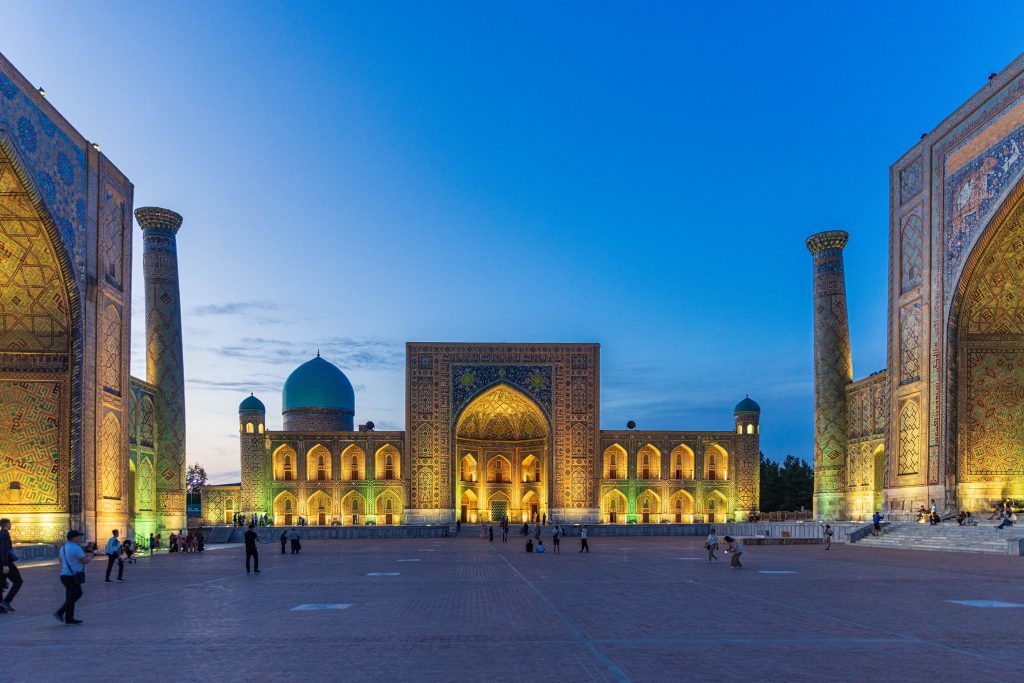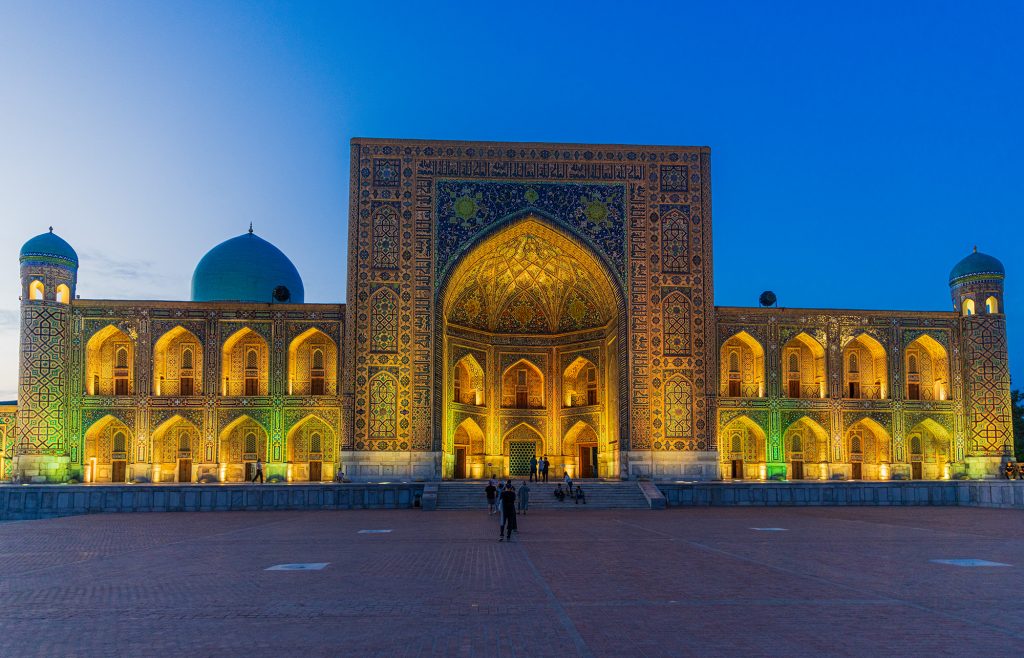Today we said good bye to Tashkent and started our journey to Samarkand with a replacement guide for two days. Unfortunately communication proved difficult as we don’t speak enough Russian and Sherbat does not speak English well. So our communication was challenging to say the least.

After a long six hours drive with some detours we had a yummy lunch in a little road side diner where we ate all sorts of salads and borscht (Ukrainian soup) as well as the best bread we have had in UZ so far. It was still warm and made with butter and you could taste it. In some sense it reminded Chris of a giant Croissant. Less sweet, but same texture. It seems to be in most traditional eating places that if you wanted to eat vegetarian, your only choice is salads. But those were very good. We also got to try a local specialty: pickled mountain onions.

Hard and crispy, they were a treat. The total for the three of us including drinks was a mere 12 Euros. Definitvely worth it.
We pocketed the spare round of bread for later and headed into Samarkand proper.
Samarkand is synonymous with the silk road. It’s one of two Uzbek cities that are called the double silk road cities as two trading routes are meeting here. A northern route through what is called today the Kyrgyz mountains in Kyrgistan and a southern route through todays Tajikistan. Both lead from China to Baghdad but take a different route depending on weather and road risk at the time. Samarkand and Buchara are the two cities that both roads touch. This importance during the high season of the Silk road was clearly visible in their impressive architectural achievements that can still be seen today.

We finally arrived at our lovely little guest house in Samarkand. Jahongir Guest house is in the middle of the old town in Samarkand and it’s only 500m walking distance from the main attraction here, Registan square with its three monumental and impressive buildings grouped around a central square. After checking in we decided that we wanted to head out alone by ourselves and experience Samarkand on foot.

We slowly wandered to Registan square and when you see it for the first time it is as awe inspiring as the Taj Mahal.
Registan originally meant sandy place or desert in Persian and was a center for education and trade. It used to be a public square where people gathered to hear royal proclamations, heralded by blasts on enormous copper pipes called dzharchis — and a place of public executions.

Three medrassas are flanking the square on three sides, the fourth one being open. Originally in the center was a large bazaar but today it’s a cobble stoned flat surface while many of the study rooms in the medrassas have been converted into little tourist and crafts shops.
While those buildings have been taken their knock over the years, the Russians actually restored them back to their old glory during their reign. Lots of colorful tiles, mosaics and art work can be seen everywhere. The buildings look more like palaces than islamic schools. Each of the three buildings looks a bit different.
The oldest is Ulugbek Medrassa, built in 1420 and that one was dedicated to studying sciences like astronomy and mathematics.

It has a nice tree lined interior courtyard and two levels of study rooms. Hidden in one of the entrances is a small wooden door.

For insiders this is the entrance door to one of the minaret towers. Chris having managed to buy ‘a ticket’ for accessing it (which is rather a bribe and limited, as not many people fit onto that staircase and look out.

You shouldn’t try this if you claustrophobic or scared of heights. But yo do get a great birds eye view from above. As it was late in the day Chris had the tower to himself and could take all the time he wanted.


Back down we wandered to the second building, the 1636 finished Sher Dor Medressa opposite the square. Despite it having been forbidden in Islam to picture people and animals, this one has a pair of lions and deer on top protecting it. One of the few depictions defying the rules. This one also had a nice interior courtyard where they kept one of the rooms as an original study room, while all others are converted into little shops.


The last and youngest one of the buildings is the Tilla Kari Medressa on the third side between the two. Built in 1660 it has a wider fassade and larger courtyard. It’s cobblestoned and very pretty.

From there a small mosque was accessible as well with pictures in black and white of the 1930‘s where we could see the poor state that Registan square and it‘s grand medrassas were in before their renovation.
We wandered through all of the buildings and just enjoyed the atmosphere of a late afternoon and early evening. As it got dusk all of a sudden the lights illuminating Registan square came on all at once and bathed everything in fantastic light.

While the setting sun shone only on some parts of the buildings before it set, the lights brigtly lit the entire square and it made everyone gasp for a short moment when that happened.

It changed the entire ensemble to produce an even grandioser effect. We simply sat on the steps and enjoyed the view and the people passing.




It was not very busy and a crowd had athered outside the square on some steps to wait for the light and music show which was supposed to start at 9 PM. We decided to wait it out and it ws OK, but it had none of the 3D effects that sometimes are being used.

After 15 min we decided to head home to our guest house and rather get an early start tomorrow to see Registan square in the early sunlight again. We have to say we would consider Registan square in Samarkand on par with the Taj Mahal.




